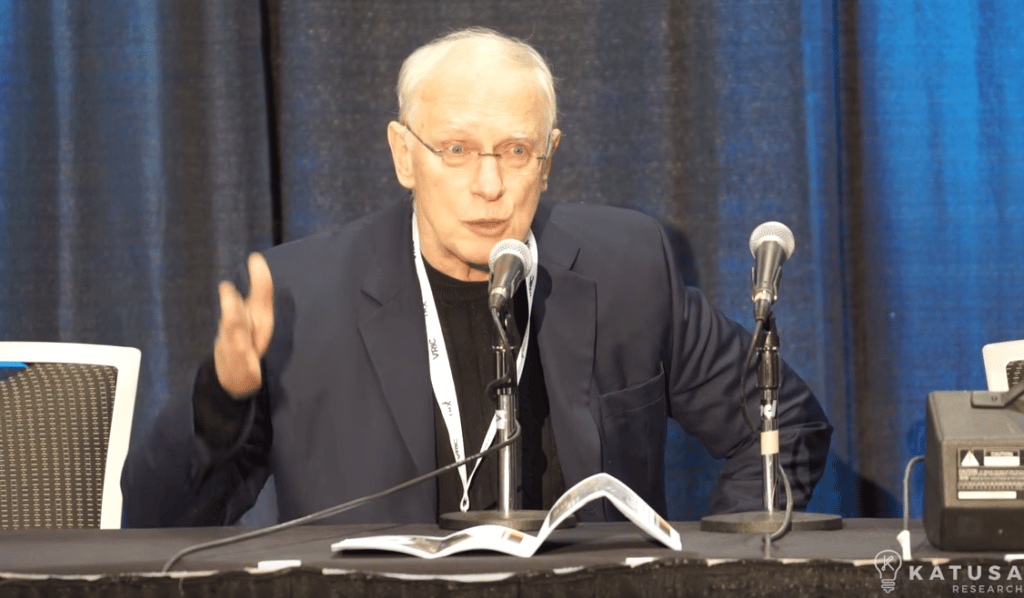
Editor’s Note: Marin Katusa recently had a question and answer workshop with legendary speculator Doug Casey at the 2018 Vancouver Resource Investment Conference. Below, you’ll find the first of their two-part interview series.
Marin Katusa:
So, Doug Casey, you have been there and done that, now you’re writing books about fiction. Is that because you’re going insane or what’s going on?
Doug Casey:
Look, the reason I’m writing these novels… first, Speculator, about the mining business and you guys are basically here about the mining business… you should read that book, Speculator. And of course, now, Drug Lord which came out last year where I show that you could be a good guy and be a drug lord. Of course this year we’re going to complete Assassin which is perhaps topical because there are all kinds of anti-thought people that have actually said they want to kill Trump so we’re looking at the history and the techniques and the morality and the practicality of political assassinations. So get those books. But the reason, Marin, to answer your question, is that there are a lot of things that you cannot say in nonfiction or you probably shouldn’t say that you can say in the form of fiction. So that’s the reason.
Marin Katusa:
For the record, we’re looking at ways to make this into a Netflix or Amazon series which it will be one day, and I’m a partner in that business. I expect it to do well. Doug, give me a couple of novels that you believe people should read to expand their horizons on investing speculation, geopolitics, that would help them become a better, wiser investor.
Doug Casey:
Yeah… novels are easier to read in many cases than nonfiction.
Marin Katusa:
Except for the Colder War.
Doug Casey:
Well, that is definitely not fiction. It is nonfiction. I’ve been a fan of Ayn Rand ever since I read her first… Well, I started out with her nonfiction, which is excellent, but if you haven’t read The Fountainhead and Atlas Shrugged, you should actually do it because everybody talks about what they think Ayn Rand said but they don’t know. Of course, she talks about business and all this type of thing. I’d put that there at number one. But I don’t read business type fiction. Frankly, I like science fiction more than anything else because, even though I don’t have a cellphone and I find that I’m becoming a dinosaur when it comes to actually manipulating the devices that people use today, I’m a technophile and most of the reading that I do is either history or science. When I read fiction, it is generally science fiction.
Marin Katusa:
Give me your two-favorite must reads….
Doug Casey:
Okay. Neal Stephenson is a genius. Anything by Neal Stephenson, you can’t go wrong with.
But my favorite by him is Diamond Age and he wrote it years ago. It accurately predicted the way, in many ways, what’s happening with nanotechnology. Nanotechnology is one of five or six technologies that are all advancing at hyper speed, faster than the rate of Moore’s law actually. You should read that book. You should read Diamond Age. You’ll really be doing yourself a favor and introduce yourself to a whole different way of thinking.
Marin Katusa:
Doug, now that you’ve kind of made a bundle of money, and I do a lot of investing for you in the funds and everything we do… looking back at your career what would have been your biggest financial mistake.
Doug Casey:
Not investigating something adequately before putting money in it. Just throwing money at it because this is a big problem.
I’ve talked with a lot of other guys about this and you get lucky in a bull market. You make a lot of money, you take the money, and you feel an obligation to reinvest the money. Very stupid. Make the money and keep the money and don’t put it back on the market. The number one mistake I’ve made. Don’t do that.
Number two is don’t hold these things too long because most, not all but most, almost all, of the stocks that you will find here, even with good people and so forth, most of them are burning matches. So don’t treat them like heirlooms. When you most want to buy more because it’s gone up a lot, you should probably think about selling instead.
So that’s another mistake I’ve made. Not being a disciplined seller. Marin is very good that way. If anything he sells too soon but that’s better than selling too late. I promise you.
Marin Katusa:
Doug, what about picking the right broker? What advice can you give someone in the audience about picking the right stockbroker?
Doug Casey:
Look, I guess everybody is using the Internet to execute their orders and so forth because you can do so very cheaply. The commissions are trivial when you use an electronic broker. I don’t do that actually. The reason why is that most of the investing that I do is with private placements and if you get good brokers that are really wired in this, they’re on the street and they can show you deals that your electronic account is not going to show you… and give you information if the broker is on the street and knows what he’s doing. I’m willing to pay a commission for that extra source of information.
Marin Katusa:
But Doug, they are called brokers, not creators. Right? They’re going to make you broke. Ironically the brokers are probably the least qualified or least educated in the financial chain and they have more influence on investment decisions than anyone else in the financial chain. So I would add the real advantage of having a full-service broker is on the warrant side if you invest in private placements. Can you explain to the crowd about the benefit of warrants and why so much of what I do focuses on warrants?
Doug Casey:
Exactly. Marin has said correctly that the ideal portfolio consists of nothing but cash and warrants.
The way it works in Canada, I’m sure you guys all know this I’m not making any cosmic breakthrough in saying this but, all of these companies are constantly raising money because very few of them have any earnings. Very few of them even have any revenues, forget about earnings. So they’re constantly selling more shares to keep the doors open and they do this in the form of private placements.
Generally, when they do a private placement it’s at a discount to the market, A, and you get a warrant, B. The warrant can be good for anywhere from as little as a year, which is not good, to as much as five years which is incidentally something that Marin has pioneered. The best kind of warrant is a five year detachable, separately tradable warrant.
Marin Katusa:
So a listed, tradeable warrant?
Doug Casey:
Exactly.
Marin Katusa:
Doug, switching gears… walk readers through the Northern Dynasty concept.
Doug Casey:
This is an ideal case. Stock is fine… an excellent basic property and the Northern Dynasty property is excellent. It’s gigantic in size and economics and so forth. Marin financed that at what, forty cents? I forget what the exact number was.
Marin Katusa:
We did three financings for a total of slightly more than $42 million all at or under $0.45.
Doug Casey:
Right, and on those, the stock later went to as high as… What did it get to? Five dollars?
Marin Katusa:
Yeah, about 4 and change…
The beauty here is every unit you bought at forty-five cents you got a warrant and the warrant traded almost as high as four dollars a share. So if you bought the stock, just the shares, you made let’s say eight or nine times your money when I wrote it up. Three or four times your money if you follow Casey Research but that’s a separate issue (I kid, as I like teasing my old friends at Casey Research about being the second best research outfit in the sector). But with the warrant, you basically double pay yourself. We’re taking all this risk if you’re accredited and this is something I tried to really push in my newsletter, Katusa’s Resource Opportunities.
Also, we broke a Toronto Stock Exchange record for a number of subscribers to take a stake, where we raised over one hundred and twenty million dollars from our newsletter base at Katusa Research. We’re really changing the whole industry so the big banks don’t like me because they’re not getting their fees. The big brokers don’t like me because they’re not getting their B warrant (broker warrant) or they call it B’s and fees, broker fees and broker warrants. All I care about is bringing us (we being the investors) to have the best advantage. So I really don’t care what the banks and the brokers do because they don’t really add that much value in my opinion.
Doug Casey:
Marin is absolutely correct.
When you’re doing these financings look at the terms of the warrant. Some people will offer an eighteen-month half-warrant. It better be a really sweet deal if that’s all they’re gonna give you for risking your money and being tied up for four months.
Marin Katusa:
Also, remember… Many people downloaded the Katusa Research guideline to a conference where you can ask all the questions to a company management team. If you haven’t, I strongly suggest you do it. Like when you ask the questions to management, such as, how much are you invested? Where you take someone like Amir Adnani that Doug and I have put millions behind… He’s invested in two companies and he owns ten percent of it himself at the same cost base as the investors. He’s got hard dollars into his company, not just “options” or what I call “soft-dollars” like most management teams in the resource sector. He is the real deal – so we back the real players like Amir, Ross Beaty, Lukas Lundin, and that elk.
Remember, soft dollars are not real money, they’re options, and these options are at five years.
Many know me as the pioneer of the five-year listed warrant, but that isn’t true. I’ve just brought it back in good style. Management teams in the resource sector have had it good during the last 15 years. All I ask is that the investors who put up real dollars to finance the management dreams to get treated equally as management. Funny thing about management, their warrants are always exercisable for 5 years. I’m yet to see a 2-year half option issued by the companies to their management. And yet they try to justify that I should buy a two-year half warrant.
The exchange used to allow a ten-year warrant back in the day. In fact, there used to be something called “piggyback warrant”. A piggyback warrant came with a unit in a PP and when the first warrant was exercised, a second warrant was issued with the exercise of the first warrant. Murray Pezim was the master of Piggy Back warrants. I’m not that greedy. I just want to be treated the same way management treat themselves.
Doug Casey:
You get the paper and the management gets to fly around in a private jet with the money you give them half the time. Ideally, five-year warrants are the best way to invest in the market but, in order to get into those deals, you’re basically either going to have to be next to a really good broker that beats the bushes for those deals, or get to know these companies. I don’t do this at Casey Research but Marin does so sign up for his newsletter and get into those deals. It’s not cheap but… Well, it is cheap actually. Because Marin is the best at this.
Marin Katusa:
It’s about value. And thanks Doug.
Doug Casey:
No, thank you Marin.
Editor’s Note: In tomorrow’s second part of the Q&A series, Marin and Doug talk two cryptocurrency plays, a junior silver company and what markets Doug Casey wants to be completely out of.






